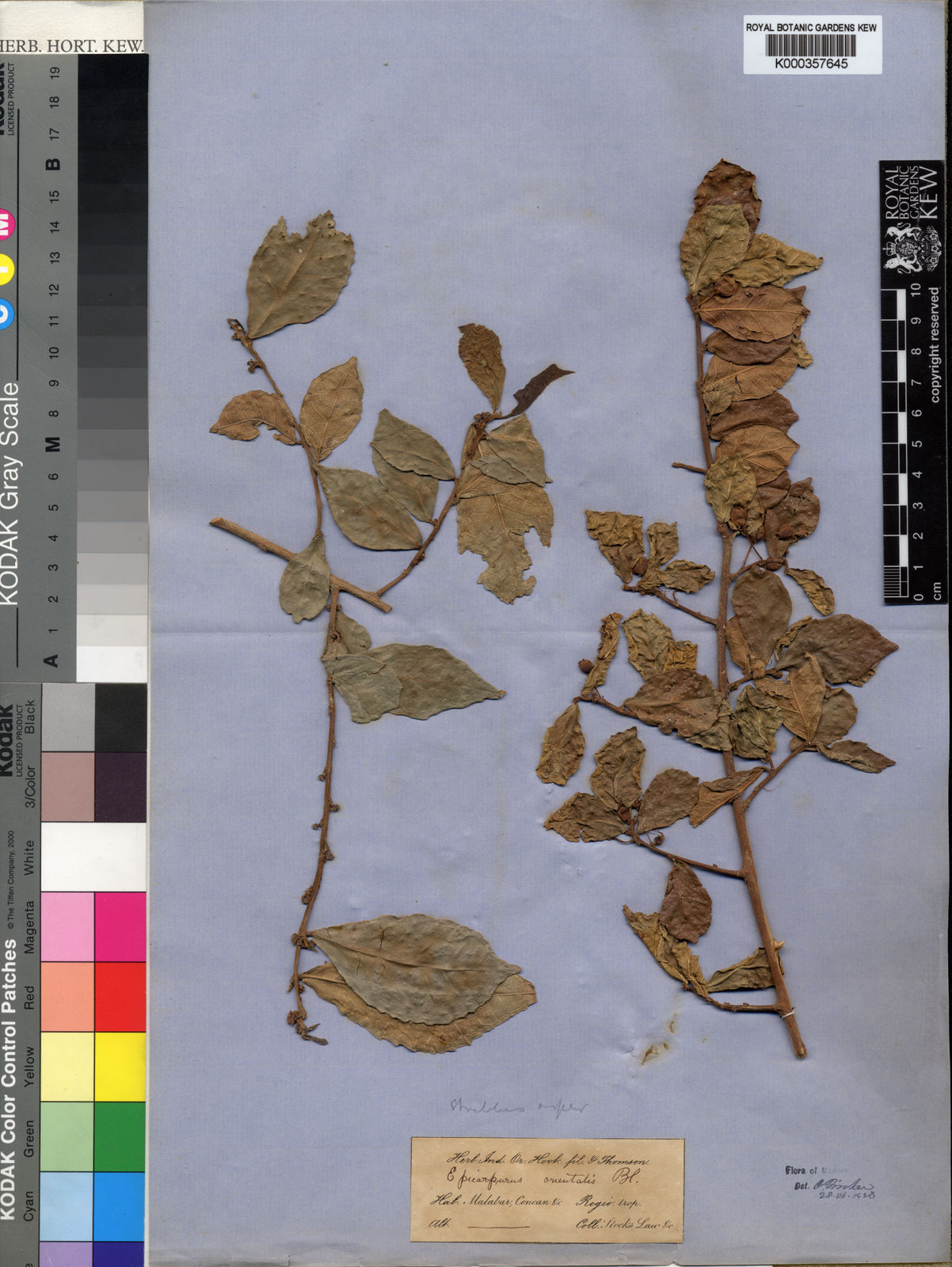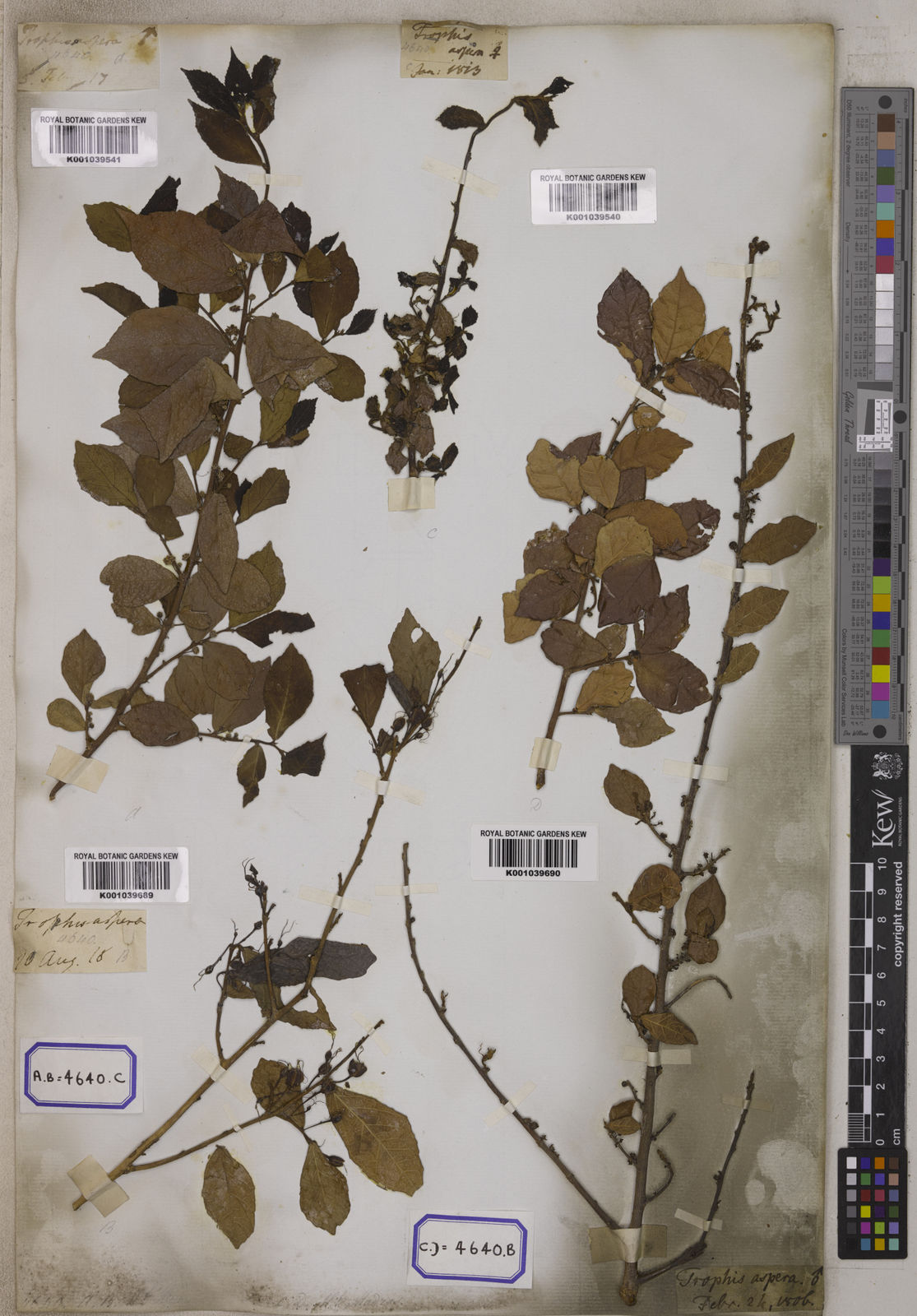Indian Mulberry
streblus asper
Also known as: ["Wild Mulberry","Tenggiri"]
Overview
A tropical tree native to Southeast Asia, known for its rough bark and small, edible fruits.
Benefits & Perks
["edible fruits","wildlife attractant (bees, butterflies, birds)","shade tolerant"]
Botanical Classification
| Phylum: | Magnoliophyta |
| Class: | Magnoliopsida |
| Order: | Rosales |
| Family: | Moraceae |
| Genus: | Streblus |
| Botanical Name: | Streblus asper |
Plant Characteristics
Basic Information
- Category: Fruits
- Suitable Location: outdoor garden in tropical or subtropical regions, or as a potted plant in a sheltered, sunny spot
- Suitable For:
- Is Weed: No
- Allergenicity: low
Environmental Needs
- Climate: {"temperatureRange":"10–35°C"}
- Hardiness: {"zones":"9–11"}
- Misting: rarely required, only if ambient humidity is very low
- Drainage: Fast-draining to prevent waterlogging.
- Soil Type: Well-draining potting mix with added perlite or coarse sand; can include some organic matter like compost.
Maintenance Level
- Maintenance Level: moderate
- Toughness Level: moderate
- Pruning Frequency: Annually in late winter or early spring before new growth begins.
- Pruning Intensity: Moderate; remove up to one-third of old growth to rejuvenate the plant.
Care Details
Ideal Sunlight Coverage:
Bright indirect light for 6–8 hours daily; can tolerate direct morning sun but avoid harsh afternoon sun.
Sunlight Tolerance Tips:
Acclimate gradually to direct sun to prevent scorching; place in a spot with filtered light if indoors; move outdoors in spring/summer for optimal growth.
Care Requirements
Care Difficulty
moderatemoderate
Sunlight
full sun to partial shade
Rotate plant weekly for even light exposure; use sheer curtains to filter intense sunlight; avoid placing near west-facing windows in summer.
Watering
every 7–10 days during active growth, reducing to every 14–21 days in winter
Water thoroughly until it drains from the bottom; allow soil to dry between waterings; avoid overwatering.
Soil
well-draining, loamy soil with moderate organic content
pH: Slightly acidic to neutral (pH 6.0–7.0).
Use a mix of cactus soil and regular potting soil; avoid heavy clay soils; check drainage by watering and observing runoff.
Temperature
Prefers 65–85°F (18–29°C); tolerates mild fluctuations but avoid prolonged exposure to extreme temperatures.
Avoid drafts; maintain consistent room temperature; protect from sudden temperature drops.
Fertilizing
every 4–6 weeks during growing season with balanced liquid fertilizer, none in winter
Fertilize after watering to prevent root burn; flush soil occasionally to prevent salt buildup; avoid overfertilizing.
Propagation
Methods
Stem cuttings in spring or early summer.
Step-by-Step Propagation Guide
- Take a 4–6 inch cutting with at least 2 nodes.
- Remove lower leaves.
- Dip in rooting hormone.
- Plant in medium.
- Keep moist and warm.
Best Time: Spring or early summer when the plant is actively growing.
Environment
High humidity (70–80%), warm temperatures (70–75°F or 21–24°C), and indirect light.
Medium
Well-draining potting mix with perlite or sand; can also root in water initially.
Hormone
Rooting hormone is recommended to improve success rates.
Timeline
Roots develop in 4–6 weeks; new growth appears in 2–3 months.
Tools Needed
Pruning shears, rooting hormone, small pots, well-draining medium, plastic wrap or propagator.
Quick Tips
Use healthy, non-flowering stems; maintain consistent moisture; provide bottom heat if possible.
Pruning & Repotting
Pruning Guide
Method
Selective thinning of branches; heading back to encourage denser growth.
Pruning Plan
Prune to maintain shape, encourage bushier growth, and remove dead or diseased branches.
Tools
Pruning shears, loppers (for larger branches), sterilizing solution.
Checklist
Sterilize tools; prune dead/damaged branches first; make clean cuts just above a node or branch junction.
Repotting Guide
Best Season
Early spring before the growing season starts.
Pot Size
One size larger pot (e.g., 2 inches wider in diameter); ensure good drainage holes.
Method
Remove plant gently; trim any circling roots; place in a slightly larger pot with fresh, well-draining soil; water thoroughly after repotting.
Suggestions
Repot every 2–3 years or when roots fill the pot; beneficial for younger plants to encourage growth.
Checklist
Choose appropriate pot size; prepare fresh soil mix; handle roots carefully; water after repotting; place in shaded area for a few days.
Advanced Care Tips
Watering Mastery
Watering Checklist
Check soil moisture; water thoroughly; ensure drainage; adjust for season.
How to Apply Water Properly
Water directly at the root zone, ensuring even saturation; water early in the morning to reduce evaporation; ensure excess water drains away to prevent waterlogging.
Watering Schedule Tips
Water deeply when the top 1–2 inches of soil are dry; reduce frequency in winter to prevent root rot.
Soil Improvement
Add perlite or coarse sand to improve drainage; incorporate compost for fertility; ensure pots have drainage holes.
Temperature Stress Management
Signs of Temperature Issues
Yellowing leaves, leaf drop, or stunted growth in cold; wilting or scorched leaves in excessive heat.
Cold Stress
Slows growth, causes leaf drop, and may lead to root damage if temperatures drop below 50°F (10°C).
Solution: Move to a warmer location; use a space heater if necessary; insulate pots with bubble wrap in cold climates.
Hot Stress
Leaves may wilt, scorch, or drop; growth may slow due to excessive transpiration.
Solution: Provide shade during peak heat; increase humidity with misting or a humidifier; ensure adequate watering.
Fertilizing Guide
Fertilizing Checklist
Check fertilizer type; dilute correctly; apply during growing season; monitor for signs of overfertilization.
Fertilizing Method
Use balanced liquid fertilizer diluted to half strength every 4–6 weeks during growing season (spring/summer); reduce or stop in fall/winter.
Common Problems & Solutions
Toxicity Warning
Cats
Slightly ToxicCats may experience mild gastrointestinal issues if they consume parts of Streblus asper. The plant's leaves and fruits are not highly toxic but can cause discomfort.
⚠️ Symptoms:
🌿 Toxic Parts:
⚡ Toxic If:
if eaten
Dogs
Slightly ToxicIn dogs, ingestion of Streblus asper can lead to mild gastrointestinal upset. The plant's leaves and fruits contain compounds that may cause discomfort but are generally not life-threatening.
⚠️ Symptoms:
🌿 Toxic Parts:
⚡ Toxic If:
if eaten
Humans
Slightly ToxicStreblus asper contains compounds that can cause mild gastrointestinal distress and skin irritation upon contact. The plant's leaves and fruits are known to have low levels of toxicity, primarily affecting the digestive system when ingested.
⚠️ Symptoms:
🌿 Toxic Parts:
⚡ Toxic If:
if eaten
Frequently Asked Questions
Q: Is the fruit of Streblus asper edible?
A: Yes, the fruit is edible and is often used in traditional medicine and local cuisines.
Q: How tall does Streblus asper grow?
A: It can grow up to 20 meters tall in its natural habitat.
Q: Does Streblus asper require full sun?
A: It prefers partial shade to full sun, depending on the climate.
Quick Reference
| Family: | Moraceae |
| Care: | moderate |
| Light: | full sun to partial shade |
| Water: | every 7–10 days during activ |
Get Expert Care Tips
Download the Plantious app for personalized care reminders and plant identification!
Google Play App Store







